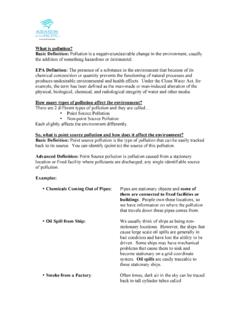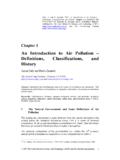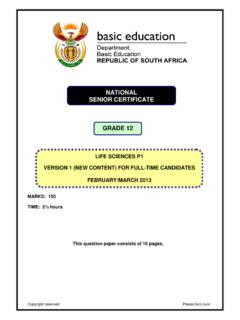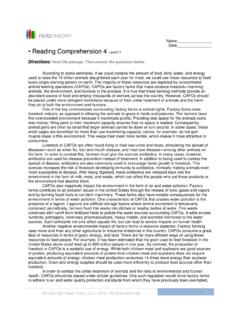Transcription of Sustainable Development in South Africa Ackoff
1 Sustainable Development in South Africa Introduction to Basic Concepts What is Economic Development and Growth? Economic Development is a continuous increase in the economic standard of living of a country's population. It is normally accomplished by doing things to improve the country's future production potential such as building more factories, educating more people, improving its technology etc. Economic growth is the increase over time in the capacity of an economy to produce goods and services and, ideally, to improve the well- being of its citizens (Deardorff's Glossary of International Economics).
2 Development Problems and Unemployment in South Africa South Africa is still a developing nation. It relies too much on extractive industries (industries that take natural resources out of the environment like mining) and on exporting natural resources in their raw forms. These industries limit South Africa 's ability to grow. For example, South Africa currently mines and exports gold ore. If it instead expanded its gold jewellery manufacturing industry, it could gain additional revenue because people pay more for gold necklaces than they do for raw ore. Still, extractive industries like mining harm the environment, but so do processes that convert ores to products like steel and aluminum.
3 For this reason, many economists and environmentalists argue that South Africa would be better off developing its human resources and knowledge based industries. Currently, South Africa is facing severe unemployment and poverty. of the population are unemployed and 50% of the population is below the poverty line. Poverty can be defined as the inability to attain a minimal standard of living or meet a person's basic needs. In South Africa , being below the poverty line means spending less than R353 per month. The prevalence of unemployment in South Africa makes rising out of poverty difficult for many people.
4 (Office of the Executive Deputy President and the Inter-Ministerial Committee for Poverty and Inequality). What is Sustainable Development ? Sustainable Development reflects a process that meets the needs of the present without compromising the ability of future generations to meet their own needs. Often called intergenerational equality, the idea is that we should share natural resources not just with people who are alive on the planet today but also with future generations of the Earth's inhabitants. While we can use a certain amount of the planet's resources, we should never entirely deplete a natural resource.
5 Sustainable Development requires people to rely as much as possible on renewable resources (the kind that can be replenished) by getting power from the sun rather than power from fossil fuels such as oil, coal, and natural gas, which take millions of years to form. Besides the careful stewardship of natural resources, Sustainable Development promotes the eradication of poverty and extreme income and wealth inequalities, the goal of full employment, the provision of access to quality and affordable basic services to all South Africans, and the fostering of a stable, safe, and just society.
6 Government Tools for Promoting Sustainable Development Taxes The government can levy taxes on industries or practices that are unsustainable. For example, the government can tax gasoline to encourage people to drive less or use public transportation more because using gasoline creates pollution . Tax breaks The government can cut the taxes of industries or individuals that act sustainably. For instance, the government can cut taxes for companies that install solar panels to generate renewable power. Subsidies The government can create an incentive for Sustainable behavior by providing the funds to start up Sustainable projects, create or update infrastructure to make industries more Sustainable , etc.
7 For example, the government can give a subsidy to farmers so that they can improve their irrigation systems to use less water. Laws and regulations that control environmental pollution and regulate Development . These would include laws and regulations that limit the amount of water or air pollution caused by factories; those that prevent Development on environmentally sensitive land;. those that protect the constitutional right to a healthy environment; those that encourage communities to become involved in decisions that affect them, such as what type of Development should take place.
8 Providing good environmental services to the people The government currently does not do enough to delivery quality environmental services (such as water and sanitation, effective waste collection and disposal systems, good drainage to prevent flooding, safe and convenient transport, parks and other recreation facilities, and effective planning for urban communities) to all people. Environmental education and awareness Government can do much to educate the public about environmental issues that affect the country as a whole and their communities in particular.
9 The Environment and Sustainable Development Environmental conditions relate to three key dimensions of poverty: (1) Livelihoods: Poor people tend to be most directly dependent on natural resources, and are therefore the first to suffer when these resources are degraded; (2) Health: Poor people suffer most when water and air are polluted because pollution sources are often placed in or near poor communities; and (3) Vulnerability: Poor people are most often exposed to environmental hazards and environment-related conflict, and are least capable of coping when they occur.
10 While wealthier people are able to afford medical care for pollution related sicknesses like asthma and are able to move out of congested and polluted areas, poor people cannot. The Legacy of Apartheid The brutal features of apartheid forced removals to less productive and less desirable areas, overcrowding in the so-called 'homelands', discriminatory policies affecting blacks who live in or near cities, and the migratory labour system alienated people from their land and resources and contributed to inequitable access to environmental services, unjust land-use policies and environmental degradation.







